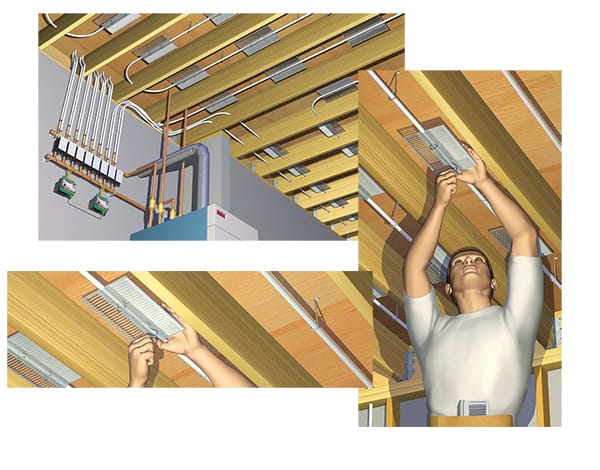Radiant floor heating systems
A Unique Solution in Radiant Floor Heating
Are you looking for energy efficiency, comfort and lifestyle? Radiant floor heating delivers it all. Radiant floor heating systems vary according to installation method, heat source, cost and complexity. Ultra-Fin® is a leader in all of these areas.
The Ultra-Fin Radiant Floor Heating System features a unique design that eliminates the complexity and high cost of traditional radiant floor heating systems. Ultra-Fin® provides huge cost savings in installation when compared to other systems, and Ultra-Fin® delivers faster response times and superior comfort during daily operation.
Easy installation
Many radiant heat systems require special engineering and hours of labor for installation. Floor structures have to be reinforced to support heavy concrete slabs, or hours of extra work are needed to secure the hot water tubing in precisely the correct orientation. Ultra-Fin® is much easier and faster to install.
With Ultra-Fin®, the tubing is simply suspended in the joist spaces beneath the floor, and the aluminum Ultra-Fins® are clipped on with a simple turnkey system. This makes installation easier and faster than most radiant heating systems. It also makes Ultra-Fin® ideal for retrofitting older homes and renovation projects with radiant heat.
Simple operation
Other hydronic radiant heat technologies rely on direct contact between hot water tubing and concrete slabs or metal transfer plates. This can present a minor hazard due to the tubing being in direct contact with your floor.
With Ultra-Fin® the heat from the hot water tubing is simply transferred to the louvered aluminum Ultra-Fins®, and the Ultra-Fins® generate hot air convection currents in the joist spaces. The heat then spreads naturally upwards and throughout the living space.
The Ultra-Fin® advantage
Even heat distribution, faster response times, superior comfort, and easy layout and zoning are the hallmarks of the Ultra-Fin Radiant Floor Heating System.


Ultra-Fin Radiant Floor Heating System
Customers often have questions about how radiant heating systems work, or about radiant heat in general. Here are some common questions and answers:
Can you create different heat zones with Ultra-Fin?
The Radiant Floor Heating System can be installed with as many or few separate heat zones as you wish. Generally, it is recommended that you establish separate heat zones for each room in the house, each controlled with a separate thermostat from the others. This is easy to do and common practice for heating contractors.
I’ve heard that radiant floor heating systems can damage hardwood floors, and that they should only be used under tile, linoleum, stone or carpet. Will Ultra-Fin work with my hardwood floors?
One of our radiant floor heating systems greatest advantages is its compatibility with all floor coverings, including hardwood, due to its very gentle and even heat distribution. While some other radiant floor heating systems have been reported at times to create concentrated “hot spots” or “striping” that cause hardwood to expand and shrink, Ultra-Fin eliminates striping with its consistent, even heat. As a result, our radiant heat system works just as well with hardwood floors as it does with carpet, tile, slate, and virtually any other flooring you can imagine.
To ensure success with hardwood, the most important step is to take special care during the installation of the hardwood flooring, carefully following the manufacturer’s guidelines. Here are some of the installation tips to remember:
Does Ultra-Fin require special measures in floor construction?
The Ultra-Fin Radiant Floor Heating System™ is specifically designed for standard wood frame construction, so you don’t need to make any changes to the basic engineering or construction methods or materials in your floor framing. Radiant floor heating systems that use concrete slabs will often require additional engineering and special construction measures to support their heavy weight, but this is not the case with our radiant heating system.
What is radiant heat?
Radiant heat is produced by infrared energy that is transmitted from a heat source in the same way that heat energy travels from our sun. (The sun doesn’t warm us with its visible light – it warms us with the infrared energy that is just below the visible light spectrum, the “light” we can’t actually see.) Infrared energy moves through the air and converts to heat when it strikes a solid object, such as a person, sofa, book or table.
How do radiant floor heating systems differ from other home heating options?
Forced air heating systems use an oil, gas or electric furnace to heat air, then they blow that heated air around the house through ducting. Occupants of the home experience “warmth” by coming into contact with the warm air. Radiant heat is different in that it does not heat the air per se, but generates invisible infrared radiant energy which then heats objects in the room (such as people) when it comes into contact with those objects. There are numerous advantages to radiant heat over forced air heat:
1. When you open an exterior door, your heat does not float out the door like it does with forced air – the heat is in your floor, not in your air, and your floor is still inside your home.
2. With radiant heat, there are no fans, blowers, or air movement, so dust and other allergens are not blown around the home.
3. Because radiant heating systems heat the occupants directly, and not the air, radiant heat systems are immediately more effective in providing direct comfort than central air heating systems.
4. Because hot air rises, most of the heat from a central forced air system ends up at the ceiling, not in the lower half of the room where people are. Radiant floor heating systems, on the other hand, radiate their most concentrated heat in the lower half of the room.
